Just about all of the best protein bars will offer flavors like Chocolate Brownie or Peanut Butter Chocolate. But if your refined palette craves unique, delectable flavors — like, say, Peppermint Bark or White Raspberry Chocolate — step right up. Quest Protein Bars go the extra mile when it comes to taste. After trying out 13 of their 20 flavors, we’d say that, overall, these puppies are tasty.
Beyond the appetizing offering of flavors, these bars are packed with an above-average dose of protein per serving, plus the macros you need to round out your daily intake. Scrutinizing the label will reveal some artificial ingredients, so anyone who needs to stick to an all-natural diet might need to keep looking, but if your stomach can, well, stomach the sweeteners and fiber, we think Quest’s lineup of flavors makes it a standout in a crowded market. Another tester and I followed BarBend’s supplement testing methodology to add some hard and fast ratings to our first-hand experience. Check out what we discovered after caving to our cravings in our Quest Protein Bar review.
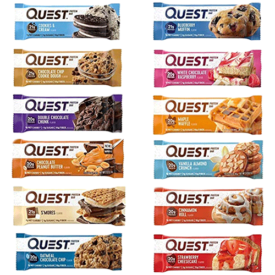
Quest Protein Bars deliver 20 grams of protein. Plus, they are soy-free, gluten-free, and keto-friendly.
Medical disclaimer: The content on BarBend is meant to be informative in nature, but it should not be taken as medical advice. The opinions and articles on this site are not intended for use as diagnosis, prevention, and/or treatment of health problems. It’s always a good idea to talk to your doctor before beginning a new fitness, nutritional, and/or supplement routine. Individual needs for vitamins and minerals will vary.
Quest Protein Bar Video Review
After sampling 13 flavors of Quest Protein Bars, it’s safe to say that we’ve had the full Quest experience. For a breakdown of those flavors, plus the nutrition under the hood, take a look at our full video review. Just remember that the formulation can vary slightly based on the flavor.
Main Takeaways
- Quest Protein Bars come in 20 different and unique flavors.
- Depending on the flavor, they offer 18 to 21 grams of protein per serving.
- Its formulation uses artificial ingredients, including sweeteners like erythritol and sucralose.
Quest Protein Bar Specs
| Price Per Bar | $2 |
| Protein Source | Whey protein isolate, milk protein isolate |
| Protein Per Serving | 18-21g |
| Carbohydrates Per Serving | 17-24g |
| Fat Per Serving | 7-9g |
| Calories Per Serving | 180-190 |
| Available Flavors | Chocolate Chip Cookie Dough, Cookies and Cream, Dipped Chocolate Peanut Butter, Oatmeal Chocolate Chip, Pumpkin Pie, Chocolate Peanut Butter, Double Chocolate Chunk, Lemon Cake, White Chocolate Raspberry, Blueberry Muffin, S’mores, Dipped Cookies & Cream, Chocolate Brownie, Mint Chocolate Chunk, Caramel Chocolate Chunk, Birthday Cake, Dipped Chocolate Chip Cookie Dough, Chocolate Sprinkled Doughnut, Apple Pie, Peppermint Bark |
If you’ve grown weary of the bland protein bars buried in your cabinet, this song’s for you. Quest’s protein-packed bars come in a whopping 20 different flavors, including unique offerings like Peppermint Bark and White Chocolate Raspberry. Over roughly a month, I tried out 13 of these flavors along with another BarBend tester, a certified nutrition coach, and learned why these gluten-free and keto-friendly snacks are some of the best low-carb protein bars out there.
“Quest Bars are one of those things that some people absolutely love – I was obsessed with them for so many years,” our tester says.
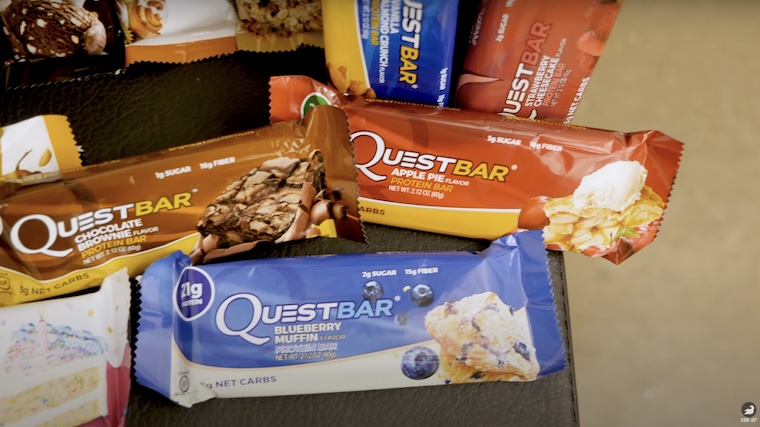
(They were only able to try out a few flavors, so since I had the chance to test out so many, I whipped up a flavor-by-flavor breakdown of eight options that I think most people would be eager to try. You can find it below.)
With so many flavors, the ingredients and dosages can vary slightly, but in each bar, you’ll find an above-average amount of protein sourced from whey protein isolate and milk protein isolate. “When checking out a protein bar’s nutrition facts, I typically scan for the protein content first. Depending on the flavor, you get somewhere between 18 and 21 grams of protein in every Quest bar. Love it,” our expert reviewer Chelsea Rae Bourgeois MS, RDN, LD says.
It wasn’t just the protein content that had Bourgeois excited. “Did y’all see that each Quest bar has 12-14 grams of fiber!? So many people fall short of their daily fiber needs, so this is a major plus for these bars.” For those with sensitive stomachs, this amount of fiber could cause some discomfort, but for anyone who struggles to get their daily recommended amount — roughly 14 grams per 1,000 calories of food — sneaking this much fiber into your protein bar could be a huge bonus. (1)

All that tasty and sweet goodness has to come from somewhere, though, and for Quest Protein Bars, it comes from artificial sweeteners. If you’re committed to an all-natural diet or are sensitive to sucralose or erythritol — like our other tester — you may need to look elsewhere. “These bars can cause digestive upset due to the level of erythritol,” they say. “I personally tolerate these well if I have them once in a while, but I find that if I have these daily, I get some serious bloating.”
Who Should Use / Who Shouldn’t Use Quest Protein Bars
If you’re finding it tough to scarf down your hundredth straight chocolate protein bar, Quest’s impressive flavor variety may be the answer. For some, the artificial sweeteners may cause more trouble than they’re worth. Check who we think is best (and worst) suited for these high-protein snacks.
Recommended for:
- Anyone seeking unique and tasty protein bar flavors
- Athletes who need to add a hefty dose of protein to their diet
- Those who struggle to get enough daily fiber
Not Recommended for:
- Users with sensitivities to artificial sweeteners
- People who don’t need help reaching their daily macronutrient targets
- Someone looking for a soft, easy-to-chew protein bar
Our Experience Using Quest Protein Bars
After trying out over 35 different protein bars, it’s safe to say the BarBend team knows what to look for in these popular snacks. When testing products, we utilize a scale of 1 (lowest) to 5 (highest), assigning scores to categories like formulation, taste, value, and more. My fellow tester and I have loads of experience with Quest Protein Bars and after sampling 13 different varieties, I offered up a quick rundown on the eight flavors that stood out to me the most. Take a look at our full experiences with these popular protein bars.
Ingredients and Formulation
Many of the best protein bars for weight loss, muscle gain, or meal replacement average around 15 to 18 grams of protein per serving. All Quest’s protein bar flavors contain at least 18 grams per bar and some even pack a whopping 21 grams. For anyone who struggles to get enough protein from whole-food sources in their regular diet, tossing one of these bars in your gym bag to eat on the go may be an easy way to bridge that gap.
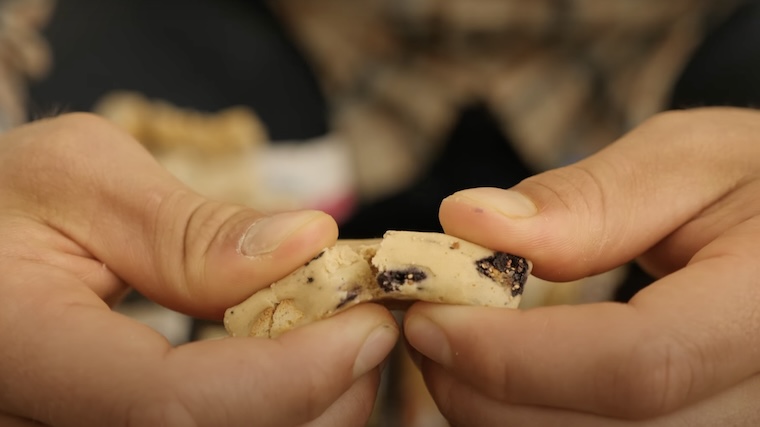
Our expert reviewer Chelsea Rae Bourgeois, MS, RDN, LD, rated its overall formulation 4 out of 5, highlighting two key factors. “The protein and fiber content in Quest bars add a nice boost to their formulation score. Their macronutrient ratio can be a good fit for many,” she says. “However, the score deductions stem from their sugar-alcohol and saturated fat content.”
Many protein powders strip away much of the fat and carbs to zero in on protein, but protein bars like these often include a bit more of each. For Quest, it comes out to roughly 21 grams of carbs and 9 grams of fat, depending on the flavor you choose.
Each bar contains negligible amounts of vitamins and minerals — 10% of your daily recommended amount of calcium is the only one worth shouting out. They also contain just 1 gram of added sugar per serving, but it comes from the artificial sweeteners erythritol and sucralose.
[Related: What Is Erythritol?]
These would disqualify them from any natural food-based diet. Research also suggests that sugar alcohols like erythritol can cause gastrointestinal issues, like bloating, for some. (2) “Quest bars are sweetened with sugar alcohols, which not everyone tolerates well,” says Bourgeois. “If that sounds like you, it might be worth scanning the flavors to find one with the least amount of sugar alcohol listed on its nutrition facts.” Because of its configuration and smaller molecular weight, erythritol may be easier on the gut than other sugar alcohols, but it’s still worth considering if you have a sensitive stomach.
Taste
In our experience, protein bars tend to offer just a handful of basic flavors, like Chocolate or Peanut Butter, in an attempt to appeal to as many people as possible. This may be a sound business strategy, but as an admitted protein bar snob, I greatly appreciate Quest’s unique flavor offering. I tried out 13 of Quest’s 20 available flavors, scoring them on a scale of 1 (yuck) to 10 (perfection). Here are the eight that stood out the most.
| Flavor | Score (out of 10) | Review |
| Cookies & Cream | 8.8 | This bar is always in my bag when traveling. It has cookie chunks in it, which gives it a chewy and dense texture, while offering a crispy bite. If you can imagine Cookies & Cream ice cream, this bar tastes very similar. |
| Oatmeal Chocolate Chip | 9.2 | I have to admit, I may be a little biased on this bar because oatmeal is one of my absolute favorite foods. Adding a boost of protein to anything resembling oatmeal chocolate chip cookies will probably get my seal of approval. I’d even call this one of the best protein snacks I’ve ever tried because it provides the subtle sweetness of the chocolate chips without overdoing it. |
| Chocolate Peanut Butter | 7 | Of all the flavors I tried, this one surprised me most — and not in a good way. The classic chocolate and peanut butter combination is one of my favorite tastes, but I thought this one missed the mark. The bar is good, but the synthetically-sweetened flavor cost it a few points. |
| Blueberry Muffin | 9 | The flavor-filled Blueberry Muffin bar was an interesting gambit from Quest, but I think they nailed it. The bits of real blueberries and little muffin crisps help make this hard-to-replicate taste pretty close to the real thing. |
| S’mores | 8 | While I’d definitely say it was good, the Quest S’mores bar never quite “wows” me. On the s’mores flavor spectrum of “roasted over a campfire” to “microwaved goop,” this protein bar falls somewhere in the middle. |
| Chocolate Brownie | 9 | Oh yeah, this one was excellent. Imagine a chewy brownie, but with a subtle sweetness and chunkier bite. A lot of protein bars offer a similar flavor because their tendency to be dense and chewy can feel like a brownie. This one was exceptional because it achieves the brownie texture without the overly tough feel of some other bars I’ve tried. |
| Birthday Cake | 8.8 | Funfetti fans, rejoice. The Birthday Cake flavor hits the target of birthday cake-flavored ice cream or cupcakes. I only shaved 1.2 points because, while the sweetness wasn’t overwhelming, I did catch a slight synthetic aftertaste. Aesthetics-wise, the sprinkles and frosting may just trick you into thinking you’re chowing down on a compacted piece of birthday cake. |
| Apple Pie | 6.4 | In Quest’s defense, Apple Pie is a high bar to aim for. I appreciate the effort, but thought the end result was just alright. Does it taste completely awful? Not at all, but I won’t be bringing home a 12-pack of these anytime soon. It carries a rather synthetically-sweet taste, without quite reaching the Apple Pie target. |
Texture
Something we notice in a lot of high-protein foods is a texture may not that matches the taste. Across the range of Quest Protein Bar flavors, however, the texture tends to complement the flavor. For example, the Blueberry Muffin option contains blueberries and muffin bits, which helps it better evoke the real thing. Similarly, the Birthday Cake flavor incorporates sprinkles and frosting. Each one I tried includes some kind of texture component that aims to make the flavor pop.
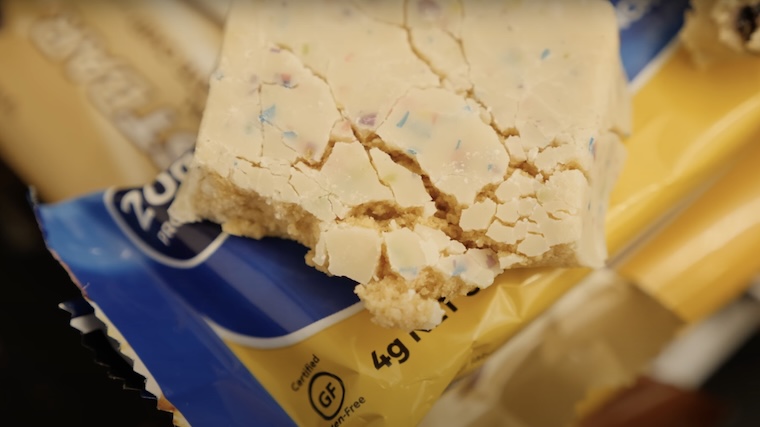
For the Chocolate Brownie flavor that our other tester tried, however, the chewiness seemed like a bit much. “These things are dense,” they say, rating the overall texture 3.5 out of 5. “I’d say they’re even chewier than RXBARs, which is saying something. Typically I enjoy chewy textures like caramels, but these were kind of a chore to chomp.”
While they certainly are chewy — like any protein bar would be — I enjoyed them because the texture tends to complement the flavor profile. Since these bars are lower in sugar content than, say, a candy bar, the texture can play a large role in creating the impression you’re indulging in a sweet treat. Granted, some of the flavors have chunky elements to them, but I didn’t think any of the 13 flavors I tried overdid it.
Price Per Serving
All the best protein chips, bars, and snacks are meant to offer a serving of protein without being a full meal. Most options out there land around $1.50 to $3.50 per bar, so Quest’s $2 price point is relatively affordable. If you buy through Amazon, you can opt for the Subscribe & Save option to take off 5%, which comes out to a savings of about 10 cents per bar.
Side Effects
I ate a ton of Quest Protein Bars and I never felt any negative side effects, but artificial sweeteners can lead to nausea or even headaches for some people. Plus, while the high fiber count may be a boon for those who don’t get enough in their diet, it could (along with the artificial sweeteners) cause tummy issues for others, like my fellow tester. “I’m fine if I have one every other day or so,” they say, scoring its side effects 4 out of 5. “But back when I used to have one everyday, I’d usually feel a bit bloated.”
What to Consider Before Buying Quest Protein Bars
Of all the protein bars I’ve tried over the years, Quest offers one of the widest varieties of flavors out there. However, if you’re looking for whole-food ingredients or truly detest that artificial-sweetener taste, you may want to keep looking. Here are a few key factors to think about when you’re considering making Quest Protein Bars your new go-to snack.
- Dietary Needs: Beyond its hearty protein content, an additional 18 to 21 grams of net carbs and 7 to 9 grams of fat may not align with certain types of diets. If you have any restrictions or are following a specific diet, remember Quest uses the artificial sweeteners erythritol and sucralose.
- Flavor: With 20 enticing options, Quest makes it easy to find a flavor match. Consider how important that variety is to you or even trying a handful of flavors before deciding which is your favorite.
- Price: At roughly $2 per bar, Quest Protein Bars land near the lower end of the typical $1.50 to $3.50 range. Ancillary sources of protein like bars and snacks shouldn’t break the bank, so consider how it will fit into your budget.
- Training Goals: Before using any protein supplement, consider how that extra dose will impact your overall fitness goals. Are you trying to bulk up? Do you want to lose weight? Think about how the additional 18 to 21 grams of protein — and carb and fat content — from your Quest bar might affect those goals.
Quest Protein Bar Vs. Competitors
Many, many (many, many) brands make protein bars because they are a convenient way to boost your daily protein intake. We’ve personally tested over 35 bars, so we lined up two other highly-rated options to see how Quest stands up. Below, check out the details on Transparent Labs Protein+ Bar and Onnit Protein Bites, one of the best protein cookies we’ve tried.
| Quest Protein Bar | Transparent Labs Protein+ Bar | Onnit Protein Bites | |
| Price Per Bar | $2 | $3.33 | $1.66 |
| Protein Source | Whey protein isolate, milk protein isolate | Grass-fed whey | Whey protein, milk protein isolate |
| Protein Per Serving | 18-21g | 15g | 7-9g |
| Carbohydrates Per Serving | 17-24g | 23g | 14g |
| Fat Per Serving | 7-9g | 16g | 6g |
| Calories Per Serving | 180-190 | 280 | 120-150 |
| Available Flavors | Chocolate Chip Cookie Dough, Cookies and Cream, Dipped Chocolate Peanut Butter, Oatmeal Chocolate Chip, Pumpkin Pie, Chocolate Peanut Butter, Double Chocolate Chunk, Lemon Cake, White Chocolate Raspberry, Blueberry Muffin, S’mores, Dipped Cookies & Cream, Chocolate Brownie, Mint Chocolate Chunk, Caramel Chocolate Chunk, Birthday Cake, Dipped Chocolate Chip Cookie Dough, Chocolate Sprinkled Doughnut, Apple Pie | Peanut Butter Chocolate Chip, Dark Chocolate Almond, Oatmeal Chocolate Chip | Cookies and Cream, S’mores, Chocolate Coconut Cashew, Chocolate Cookie Dough, Chocolate Peanut Butter |
If you’ve made this far in my review, it should come as no surprise that Quest is a clear winner in terms of available flavors. I tried out 13 of them and all of them were solid, but a few were incredible. Our team rates the taste of both Transparent Labs and Onnit highly as well (4 out of 5 and 5 out of 5, respectively), but if any of those flavors don’t appeal to you, chances are Quest has something that may tickle your fancy.
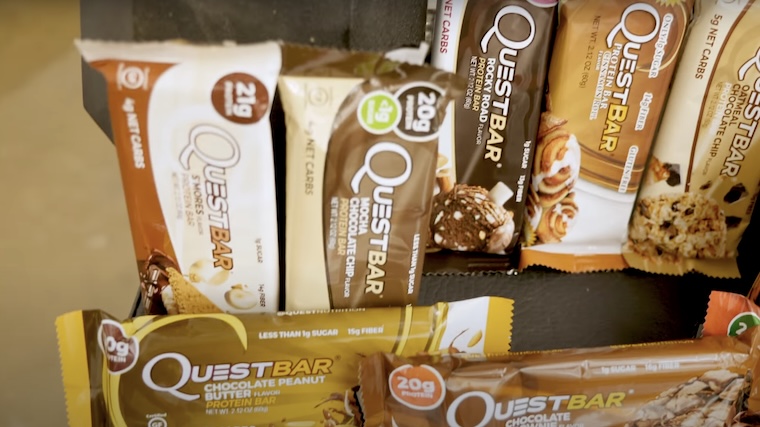
All three of these are some of the best pre-workout snacks we could recommend, but you’ll notice that Quest bars cost less than Transparent Labs, but slightly more than Onnit. Quest lands above Onnit primarily because of the protein per serving — 18 to 21 grams vs. 7 to 9 grams — but below Transparent Labs because of its use of artificial ingredients.
“I like the list of wholesome ingredients featured in Transparent Labs Grass-Fed Protein+ Bars,” says our expert reviewer Chelsea Rae Bourgeois, a registered dietitian nutritionist. That all-natural formulation earned a 4.5 out of 5 from Bourgeois and is an important selling point for those who need to avoid synthetic ingredients.
Places to Buy Quest Protein Bars
You can order Quest Protein Bars online straight from questnutrition.com or Amazon. They are also readily available at grocery stores, major retailers, and even convenience stores.
Customer Experience and Brand Reputation
From their start in 2010, Quest Nutrition has grown from solely making protein bars to multiple types of protein-focused foods. Quest Nutrition was founded on the premise of setting out to create protein-loaded foods that help limit the amount of sugar people are consuming on a regular basis, along with increasing dietary fiber.
Over the eye-popping 19,000 customer ratings on Amazon, several themes emerge. Like us, Quest Protein Bars score high for the protein content and taste. While we didn’t think the texture was too bad, some reported they felt it was a bit too tough to chew comfortably.
Our Final Verdict on Quest Protein Bar
With so many available flavors, you’d have to be a rather picky eater to not find a suitable option from Quest. These convenient protein bars have been one of my favorite on-the-go snacks for years, so when I got to try 13 of their 20 flavors, I was excited, to say the least. Compared to most protein bars on the market, they also offer up a hefty dose of protein — 18 to 21 grams. Depending on how much protein you need per day, that amount could be a big boost to reach your ideal intake.
I think the macro count makes them a great choice for anyone who needs a bit of help hitting those daily targets, plus all the fiber can help you feel fuller between meals. People who might be sensitive to artificial sweeteners (or all that fiber) may want to consult with their tummies before securing a 12-pack. But if your stomach gives you the all-clear, Quest Protein Bars are an affordable option for adding a sizable chunk of protein to your diet.
Quest Protein Bar Review FAQs
Are Quest Protein Bars good for you?
The 18 to 21 grams of protein in Quest Protein Bars can help you hit your daily protein targets, which is good. It does, however, contain some artificial ingredients, which some may want to avoid. In the end, it comes down to your dietary preferences and nutritional needs, but we think these bars are a perfectly healthy snack when eaten responsibly.
What are Quest Protein Bars sweetened with?
Quest uses the artificial sweeteners erythritol and sucralose to achieve their appetizing taste. For a naturally-derived sweetener, look for protein bars that use something like stevia or monk fruit extract.
Are Quest Protein Bars a meal replacement?
Quest Protein Bars have the macro content — carbs, fat, and protein — to complement the best meal replacement or protein shakes, but it lacks the calories to be a proper meal replacement in itself. Most meal replacements offer at least 400 calories per serving and a decent amount of vitamins and minerals. So, Quest’s 180 to 190 calories per bar and limited micronutrients don’t quite offer enough to cut out a whole meal.
Are Quest Protein Bars good for weight loss?
Each Quest bar offers between 180 and 190 calories, so factor that into your daily intake when you’re trying to manage your weight. “Your body requires a certain amount of energy — measured in calories — to stay alive and perform all of your daily activities,” BarBend expert reviewer Gabrielle Fundaro, Ph.D. explains in her article about calorie deficits. “When you’re in a calorie deficit, you lose weight because your body has to release the energy stored in your body fat in order to meet your energy needs.”
References
- Anderson, J. W., Baird, P., Davis, R. H., Jr, Ferreri, S., Knudtson, M., Koraym, A., Waters, V., & Williams, C. L. (2009). Health benefits of dietary fiber. Nutrition reviews, 67(4), 188–205.
- Mäkinen K. K. (2016). Gastrointestinal Disturbances Associated with the Consumption of Sugar Alcohols with Special Consideration of Xylitol: Scientific Review and Instructions for Dentists and Other Health-Care Professionals. International journal of dentistry, 2016, 5967907.